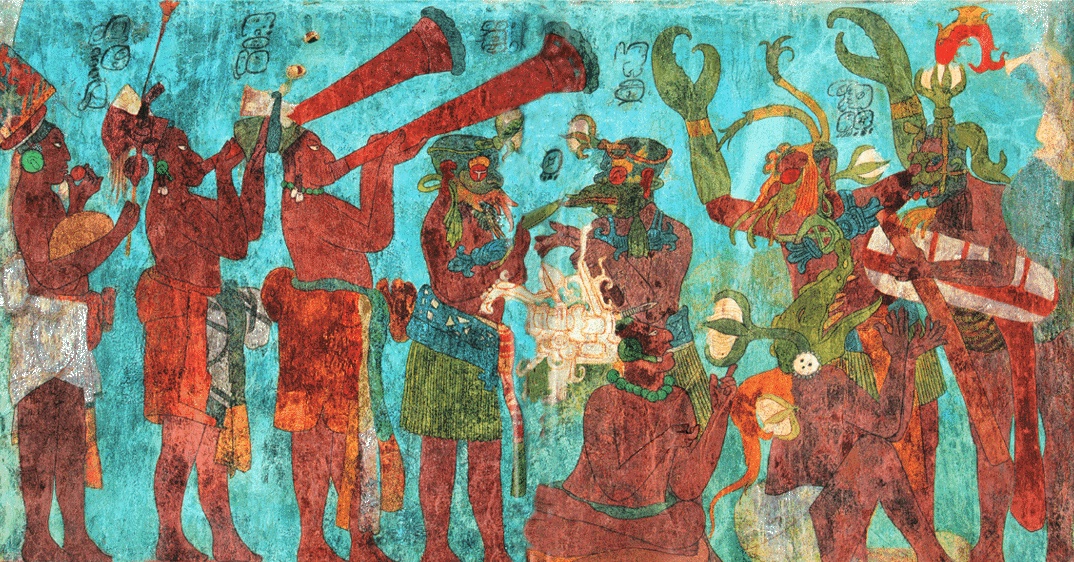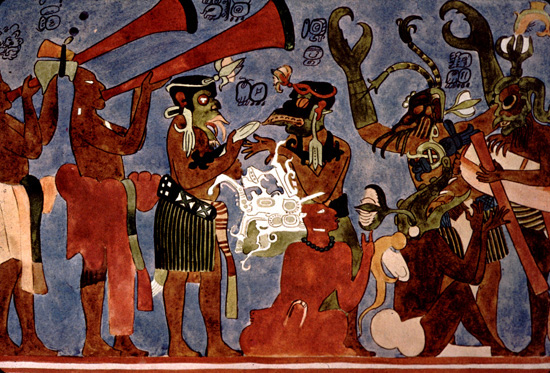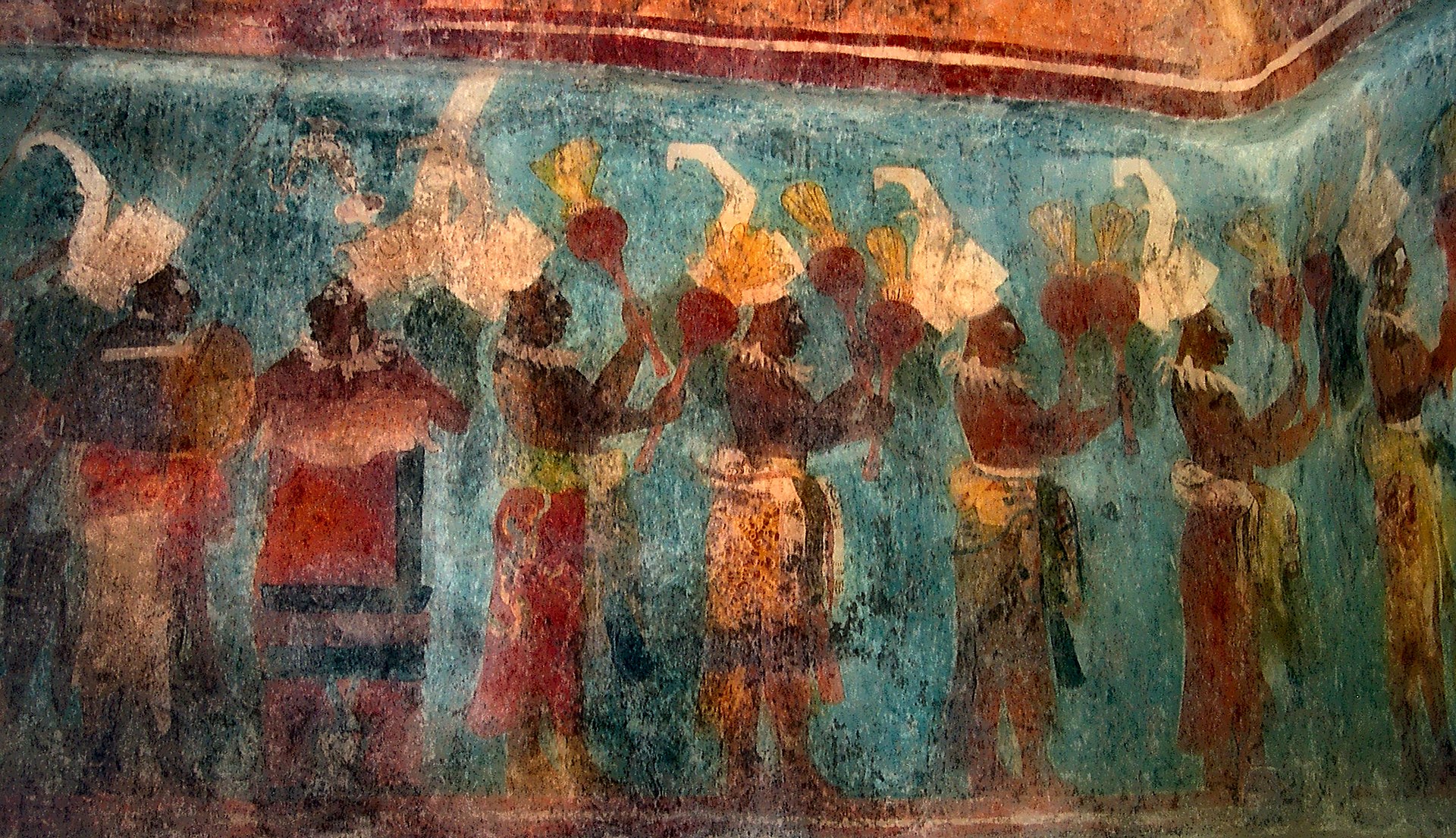
マヤ伝統音楽
Maya music
Bonampak temple room 1, file of musicians: rattle and ocarina; trumpets; and theatrical scene
☆ 古代マヤ族の音楽は、16世紀の先住民やスペインの書物に記述され、古典期(西暦200〜900年)の美術品に表現されている。マヤ族はトランペット、フ ルート、笛、太鼓などの楽器を演奏し、葬儀や祝い事、その他の儀式に音楽を用いていた。書かれた音楽は残っていないが、考古学者たちは、音楽が社会的・宗 教的構造の複雑な一部であったことを示す古代マヤの楽器や絵画・彫刻表現を発掘している。スペインの征服によってマヤの宮廷が解体された後、音楽そのもの はほとんど姿を消した。しかし、いくつかのマヤ音楽は残っており、スペインの影響と融合していた。
| The
music of the ancient Mayan courts is described throughout native and
Spanish 16th-century texts and is depicted in the art of the Classic
Period (200–900 AD). The Maya played instruments such as trumpets,
flutes, whistles, and drums, and used music to accompany funerals,
celebrations, and other rituals. Although no written music has
survived, archaeologists have excavated musical instruments and painted
and carved depictions of the ancient Maya that show how music was a
complex element of societal and religious structure. Most of the music
itself disappeared after the dissolution of the Maya courts following
the Spanish Conquest. Some Mayan music has prevailed, however, and has
been fused with Spanish influences. ++++ La musique des anciennes tribus mayas est décrite dans des textes autochtones et espagnols du XVIe siècle et est représentée dans l'art de la période classique (200-900 après J.-C.). Les Mayas jouaient d'instruments tels que des trompettes, des flûtes, des sifflets et des tambours, et utilisaient la musique pour accompagner les funérailles, les célébrations et autres rituels. Bien qu'aucune musique écrite n'ait survécu, les archéologues ont mis au jour des instruments de musique et des représentations peintes et sculptées des anciens Mayas qui montrent que la musique était un élément complexe de la structure sociétale et religieuse. La plupart de la musique elle-même a disparu après la dissolution des cours mayas à la suite de la conquête espagnole. Une partie de la musique maya a cependant subsisté et s'est mêlée aux influences espagnoles. |
古
代マヤの宮廷音楽は、16世紀の原住民やスペインの書物に記述され、古典期(西暦200〜900年)の芸術作品にも描かれている。マヤはトランペット、フ
ルート、口笛、太鼓などの楽器を演奏し、葬儀や祝い事、その他の儀式に音楽を用いていた。書かれた音楽は残っていないが、考古学者たちは、音楽が社会や宗
教構造の複雑な要素であったことを示す、古代マヤの楽器や絵や彫刻の描写を発掘している。スペインによる征服後、マヤの宮廷が解体されると、音楽そのもの
はほとんど姿を消した。しかし、一部のマヤ音楽は残っており、スペインの影響と融合している。 ++++ 古代マヤ族の音楽は、16世紀の先住民やスペインの書物に記述され、古典期(西暦200〜900年)の美術品に表現されている。マヤ族はトランペット、フ ルート、笛、太鼓などの楽器を演奏し、葬儀や祝い事、その他の儀式に音楽を用いていた。書かれた音楽は残っていないが、考古学者たちは、音楽が社会的・宗 教的構造の複雑な一部であったことを示す古代マヤの楽器や絵画・彫刻表現を発掘している。スペインの征服によってマヤの宮廷が解体された後、音楽そのもの はほとんど姿を消した。しかし、いくつかのマヤ音楽は残っており、スペインの影響と融合していた。 |
Instruments Bonampak temple room 1, file of musicians: rattle and ocarina; trumpets; and theatrical scene Important archaeological evidence of pre-Columbian Maya aerophones has been found in locations such as Tabasco, Campeche, and Jaina. Clay whistles were found in Jaina from burial sites. These whistles have mouthpieces in quadrangular, rectangular, ellipsoidal and conical shapes. Several whistles are shaped like human faces, and some are shaped like animals representing Mayan deities.[1] Aside from wind and percussive instruments there was not a wide variety of instruments used in classic Mayan music, as stringed instruments such as guitars were not invented in the region.[2] Deceased rulers were often buried with musical instruments to help them pass through the underworld and to eventually be reborn.[3] Trumpets There were several different types of Mayan trumpets. Some were made of clay and were relatively short, and wooden trumpets were much longer.[4] A wall painting dating from c. 775 CE found at the Bonampak ceremonial complex in the dense jungles of Chiapas depicts twin trumpeters standing side by side in a 12-man orchestra.[5] This, and other artistic depictions of Mayan trumpeters depict the lips of the players being held very tightly over the mouthpiece, suggesting that the wooden trumpets were used to blow higher overtones.[6] While the use of clay trumpets gradually diminished, the use of wooden trumpets persisted. "Long thin trumpets of hollow wood with long twisted gourds at the ends" still existed by the time Diego de Landa wrote his Relación in 1566.[7]  Los murales de Bonampak también muestran a un grupo de guerreros mayas tocando largas trompetas como todavía aparecen en el Rabinal Achi del siglo xix. Flutes The Maya used many different types of flutes, some much like modern flutes and others very different. A common type of Mayan flute had a goitre chamber on the side which was used to deflect the air going into the instrument from taking a straight path. This caused the instrument to produce a sound more closely resembling that of an oboe.[8] Another type of flute used was a tube flute which was capable of producing 3 note chords, a role not commonly fulfilled by wind instruments.[9] The Maya also played the Ocarina, a small, whistle-sized Vessel flute. Depending on their construction, ocarinas were capable of producing five different pitches by way of four or five holes in the instrument. Certain studies and excavation reports of ancient Maya sites speculate that ocarinas were played during small cult rituals and burial ceremonies. Larger flutes were capable of producing more pitches. The Dresden Codex, a book that dates to the thirteenth or fourteenth century which contains 78 pages of ancient Maya hieroglyphs, depicts images of people playing drums and flutes. Template 34 of the Dresden Codex depicts the flute as an instrument associated with a fertility or thanksgiving ritual.[10] Percussion  Bonampak temple room 1, file of musicians: portable turtle drum, standing drum, and maracas Mayan percussion commonly consisted of drums and rattles. Two of the three surviving pre-Columbian Mayan manuscripts in European libraries discuss the kayum, an upright single-headed cylindrical or kettle-shaped drum, played barehanded. The top and bottom panels in side 63 (34) of the Dresden Manuscript depict deities playing drums whose clay frames look like two arms of a candelabra. The arms are covered by a tied hide, and the base joining the two arms is filled with water, enabling the player to adjust the pitch of the drum. The Dresden Manuscript also shows an image of a deity shaking a large perforated rattle and another playing an end-blown flute. Glyphs that represent musical sound from both the drum and flute.[11] Large vertical drums (which the Aztecs called huehuetl) were made of wood and did not survive. The much lower standing kettle drums that have been found - often shaped like a bulbous jar on a pedestal, single or double - are earthenware. In depictions, the membrane is sometimes shown to consist of a jaguar pelt. In the Late-Postclassic Dresden Codex (34a), the drum connects to an open resonance chamber without membrane. Another type of kettle drum was portable and held under the arm.[12] The horizontal slit-drums (tun, Aztec teponaztli) appear only after the close of the Classic Period, probably under Toltec influence. In addition there were tortoiseshell and turtleshell drums played with the hand (Herrera), or with a stick such as a deer antler. Metal instruments generally had no place in Classic Mayan music. The exception to this were pellet-bell rattles, which represented the god of death.[13] The hundred golden pellet-bell rattles found in 1926 at the Sacred Well at Chichen-Itza were brought to the site from afar. The Dresden and Madrid manuscripts depict gods ornamented with jingles.[14] +++++++++++++++++++++++++++++++ Performance and religious significance +++++++++++++++++++++++++++++++ Theatrical events, dance, ritual, and, to a lesser extent, even warfare would have been unthinkable without musical support.[15] Therefore, the musical director in Yucatán, the holpop, was held in high esteem.[16] Maya dictionaries, both ancient and more recent, contain many words and distinctions related to music, such as, for example, Chʼortiʼ lahb "stroke [a drum] with the dexterity of a tortilla maker."[17] The 16th-century Quiché-Maya hero myth of the Popol Vuh stages the brothers Hun-Batz and Hun-Choven as flautists and singers, while describing them as patrons of the other arts as well; the Hero Twins transform them into monkeys by playing the flute and the drum and by singing a certain tune.[18] The musical Elder Brethren correspond to the Howler Monkey Gods of the Classic period. In the Classic and Late-Preclassic Periods, the Tonsured Maize God - another deity of the arts - is intimately connected to a small, portable turtle drum; the deity of the day Ik' (Wind) is sometimes shown as a musician shaking rattles. Particularly the drums, whether the slit-drum, the kettle drum, or the high wooden drum, appear with specific rhythmical motifs to have initiated the musical performances, or, as Gerónimo de Mendieta states in writing about the native music of New Spain, "when the dancers hear that the kettle drums [atabales] start, they understand by their tone the song and the dance, and then start it."[19] According to Cogolludo, the holpop was not only "the principal singer who sets the key and teaches what is necessary to sing," but also the keeper of the musical instruments, first of all the [horizontal] tunkul drums.[20] In the Rabinal Achí, a Highland Maya 'tun-dance' drama dating back to the 16th century, the stage and music director is usually the one who plays the ancient wooden slit-drum (tun), accompanied by two trumpets. The most complete depiction of a Classical period musical performance is that on the lower walls of a Bonampak temple room (room 1). Dating back to AD 791, it shows a royal dance accompanied by a file of twelve musicians divided into sections: pairs of large rattles (5 players) - a high, vertical drum (1 player) - large, portable turtle/tortoise drums played with sticks (3 players) - long trumpets (2 players) - rattle and ocarina (1 player). In between the turtle drums and the trumpets is a group of five theatrical impersonators surrounding a young noblewoman. The trumpets may have started, with the standing drum then assuming the lead part. Among the Maya, group dances were considered highly sacred. According to Bishop Diego de Landa groups of men and women danced separately and had particular musical ceremonies in which they specialized. De Landa described a dance in which two men led the steps. One hurled reeds at the other man for him to catch, while they both performed complicated dance steps. Landa also witnessed a sacred war dance, in which as many as 800 men carrying small banners followed a complex pattern of steps in perfect unison.[21] Some of the earliest known Mayan dances were associated with shamanistic rituals and altered states of conscious. Dance may have been a way of giving sacred beings life and voice through the dancer's movement and song. Combined with music and the fragrance of burning offerings, dance was often regarded as the direct manifestation of supernatural forces.[22] |
楽器 ボナンパク神殿第1室、演奏者のファイル:ガラガラとオカリナ、トランペット、演劇の場面 タバスコ、カンペチェ、ジャイナなどでは、先コロンブス期マヤの気球の重要な考古学的証拠が発見されている。ジャイナでは埋葬地から土製の口笛が発見され た。これらの口笛は、四角形、長方形、楕円形、円錐形をしている。いくつかの口笛は人の顔の形をしており、マヤの神々を表す動物の形をしているものもある [1]。 ギターのような弦楽器はこの地域では発明されていなかったため、管楽器や打楽器を除けば、古典的なマヤ音楽で使用される楽器の種類はそれほど多くなかった [2]。 死んだ支配者は、冥界を通過し、最終的に生まれ変わるのを助けるために、しばしば楽器と共に埋葬された[3]。 トランペット マヤのトランペットにはいくつかの種類があった。チアパスの密林にあるボナンパクの儀式施設で発見された紀元775年頃の壁画には、12人のオーケストラ の中で並んで立つ双子のトランペット奏者が描かれている[5]。 [5]この絵や他のマヤのトランペット奏者の芸術的描写は、奏者の唇がマウスピースの上に非常に強く保持されていることを描いており、木製のトランペット がより高い倍音を吹くために使用されていたことを示唆している[6]。ディエゴ・デ・ランダが1566年に『Relación』を執筆する頃には、「両端 に長いねじれたひょうたんをつけた中空の木の細長いトランペット」がまだ存在していた[7]。  ボナンパクの壁画には、19世紀のラビナル・アチに描かれていたような、長いラッパを吹くマヤの戦士たちの姿も描かれている。 フルート マヤは、現代のフルートとよく似たものもあれば、全く異なるものもある、多くの異なるタイプのフルートを使用していた。マヤのフルートの一般的なタイプ は、楽器に入る空気がまっすぐな経路を取ることからそらすために使用されたゴイトレチャンバーを側面に持っていた。このため、楽器はオーボエに近い音を出 すようになった。[8] また、管楽器では一般的でない3音の和音を出すことができる管楽器も使われた。構造にもよるが、オカリナは楽器の4つまたは5つの穴によって5つの異なる 音程を出すことができた。ある研究や古代マヤ遺跡の発掘報告によると、オカリナは小さなカルト儀式や埋葬儀式の際に演奏されたと推測されている。より大き なフルートは、より多くの音程を出すことができた。ドレスデン写本は13世紀か14世紀の本で、78ページに及ぶ古代マヤのヒエログリフが記載されている が、そこには太鼓や笛を演奏する人々の姿が描かれている。ドレスデン写本のテンプレート34には、豊穣や感謝の儀式に関連する楽器としてフルートが描かれ ている[10]。 打楽器  ボナンパク神殿第1室、演奏者のファイル:携帯用カメのドラム、スタンディングドラム、マラカス マヤの打楽器は一般的に太鼓とガラガラであった。ヨーロッパの図書館に現存するコロンブス以前のマヤの写本3点のうち2点は、素手で演奏する直立した片頭 の円筒形またはやかん形の太鼓、カユムについて述べている。ドレスデン手稿の第63面(34)の上下のパネルには、太鼓を叩く神々が描かれており、その粘 土の枠は燭台の2本の腕のように見える。両腕は縛られた皮で覆われ、両腕をつなぐ台座には水が満たされており、演奏者が太鼓の音程を調節できるようになっ ている。ドレスデン手稿には、大きな穴のあいたガラガラを振る神像と、端吹き笛を吹く神像も描かれている。太鼓と笛の両方からの楽音を表すグリフ [11]。 大きな縦長の太鼓(アステカ人はフエヘトルと呼んでいた)は木製で、現存していない。発見されているのは、台座の上に置かれた球根状の壺のような形をし た、一重または二重の、はるかに低い立釜の太鼓で、土器であることが多い。描かれた絵には、ジャガーの毛皮でできた膜が描かれていることもある。後期後古 典期のドレスデン写本(34a)では、太鼓は膜のない開放共鳴室につながっている。別のタイプのケトル・ドラムは持ち運び可能で、腕の下に抱えていた [12]。横長のスリット・ドラム(tun、アステカのテポナズトリ)は古典期末以降に初めて登場し、おそらくトルテカの影響を受けていた。さらに、手 (エレラ)や鹿の角のような棒で叩くべっ甲や亀甲の太鼓もあった。古典的なマヤの音楽には、一般的に金属製の楽器は使われていなかった。1926年にチ チェン・イッツァの聖なる井戸で発見された100個の黄金のペレットベル・ラトルは、遠くから運ばれてきたものである。ドレスデンやマドリードの写本に は、鈴で飾られた神々が描かれている[14]。 +++++++++++++++++++++++++++++++ パフォーマンスと宗教的意義 +++++++++++++++++++++++++++++++ 演劇、舞踊、儀式、そして、少しではあるが、戦争でさえも、音楽のサポートなしには考えられなかっただろう[15]。 そのため、ユカタンでは、音楽監督であるホルポップが高い尊敬を集めていた[16]。 16世紀のキチェ=マヤの英雄神話『ポポル・ヴフ』では、フン=バッツとフン=チョー ヴェンの兄弟がフルート奏者と歌手として登場し、他の芸術の後援者としても描かれている。古典期と後期先古典期には、もう一人の芸術の神であるトンスル・ メイズ神が、持ち運び可能な小型の亀の太鼓と密接に結びついている。あるいは、ジェロニモ・デ・メンディエタがニュー・スペインの先住民の音楽について書 いているように、「釜太鼓(atabales)が始まると、踊り手はその音色で歌と踊りを理解し、それを始める」[19]。 コゴルドによれば、ホルポップは「調を決め、歌うために必要なことを教える主要な歌い手」であるだけでなく、楽器の管理者でもあった。16世紀に遡るハイ ランド・マヤの「トゥン・ダンス」劇であるラビナル・アチでは、舞台監督兼音楽監督は通常、2本のトランペットを伴って古代の木製のスリット・ドラム (トゥン)を演奏する者である。古典期の音楽演奏の最も完全な描写は、ボナンパク寺院の部屋(部屋1)の下の壁に描かれたものである。AD791年のもの で、大きなガラガラのペア(5人)、高くて縦長の太鼓(1人)、スティックで演奏する持ち運び可能な大きな亀の太鼓(3人)、長いトランペット(2人)、 ガラガラとオカリナ(1人)というセクションに分かれた12人の音楽家の列を従えた王族の踊りが描かれている。亀の太鼓とトランペットの間には、若い貴婦 人を取り囲む5人の劇団員がいる。トランペットが始まり、立鼓がリード・パートを担当したのだろう。マヤでは、群舞は非常に神聖なものと考えられていた。 ディエゴ・デ・ランダ司教によると、男女のグループは別々に踊り、それぞれに特化した音楽儀式を持っていた。デ・ランダは、2人の男性がステップを踏むダ ンスを描写している。一人がもう一人に葦を投げつけてキャッチさせ、二人で複雑なステップを踏む。ランダはまた、小さな旗を携えた800人もの男たちが、 複雑なステップのパターンを完璧なユニゾンでたどる神聖な戦争ダンスを目撃した[21]。最も古くから知られているマヤのダンスのいくつかは、シャーマニ ズムの儀式や意識の変容状態と関連していた。ダンスは、ダンサーの動きと歌を通して神聖な存在に生命と声を与える方法だったのかもしれない。音楽や燃える 供物の香りと組み合わされ、ダンスはしばしば超自然的な力の直接的な現れとみなされた[22]。 |
| Mayan music today Indigenous Mayan music can still be heard today in Yucatán and Chiapas. The tunkul (a slit drum) and the bulalek (water drum) are played in Yucatán during Christian religious festivities. The Tzotzil and Tzèltal are groups of indigenous people located in the highlands of Chiapas who have retained a great variety of traditional Mayan dances, accompanied by a combination of indigenous instruments and European instruments. One dance includes the danza del agua, (water dance) of San Juan Chamula, accompanied by a double-headed cylindrical drum and a 12-string guitar. This dance is performed at Catholic ceremonies. Other dances of this region include the yojualelvinajil, accompanied by a harp and 12-string guitar, and the quintajimoltic, a carnival dance accompanied by a single-headed drum and a cane flute. The drum is made out of a clay pot with a single skin head covering the mouth of the pot.[23] A regional music known as jarana is played today in Yucatán. Jarana has strong European roots, emphasized by the presence of brass bands and Hemiola rhythms. Jaranas are danced to in order to honor patron saints at Christian festivities, and are still performed at certain Maya rituals in honor of ancient Mayan deities, such as Chaac, the Mayan god of rain. Christian practices have been integrated into Mayan rituals. Another style of music is called son de maya pax, played in Quintana Roo, accompanied by violins, cornets, snare drums and bass drums.[24] In the Guatemalan highlands, the Colonial and post-Colonial music of the Spanish has fused with indigenous Maya music. This syncretic music is used to accompany dance plays, and Maya communal performance events involving dance, theatre, and music. There are several types of highland Guatemalan dance plays, and each play is characterized by a theme (i.e. conquest, hunting, and sacrifice.) Today these performance events are called bailes and they are performed at a town's central church during festivals honoring saints.[25] One of these dances is the Kʼicheʼ Warrior Dance, dating back to the Postclassic era. This dance was accompanied by flutes and drums and was a pre-battle music and dance ceremony. It is thought that flutes, drums, and shells were sounded during battles in the Guatemalan highlands. Other dances include the deer dance, Baile del Venado which pairs an indigenous hunting theme with Western musical instruments such as the marimba.[26] +++++++++++++++++++++++++ La musique maya aujourd'hui La musique indigène maya peut encore être entendue aujourd'hui au Yucatán et au Chiapas. Le tunkul (tambour à fente) et le bulalek (tambour à eau) sont joués au Yucatán lors des festivités religieuses chrétiennes. Les Tzotzil et Tzèltal sont des groupes d'indigènes situés sur les hauts plateaux du Chiapas qui ont conservé une grande variété de danses mayas traditionnelles, accompagnées d'une combinaison d'instruments indigènes et européens. L'une de ces danses est la danza del agua, (danse de l'eau) de San Juan Chamula, accompagnée d'un tambour cylindrique à deux têtes et d'une guitare à 12 cordes. Cette danse est exécutée lors des cérémonies catholiques. Parmi les autres danses de cette région, citons le yojualelvinajil, accompagné d'une harpe et d'une guitare à 12 cordes, et le quintajimoltic, une danse de carnaval accompagnée d'un tambour à une tête et d'une flûte de canne. Le tambour est fait d'un pot en argile avec une seule tête en peau qui recouvre l'ouverture du pot1. Une musique régionale connue sous le nom de jarana est jouée aujourd'hui au Yucatán. La jarana a de fortes racines européennes, soulignées par la présence de fanfares et de rythmes Hemiola. Les jaranas sont dansées pour honorer les saints patrons lors de festivités chrétiennes, et sont encore exécutées lors de certains rituels mayas en l'honneur d'anciennes divinités mayas, comme Chaac, le dieu maya de la pluie. Les pratiques chrétiennes ont été intégrées aux rituels mayas. Un autre style de musique est appelé son de maya pax, joué à Quintana Roo, accompagné de violons, de cornets, de caisses claires et de grosses caisses1. Dans les hauts plateaux du Guatemala, la musique coloniale et post-coloniale des Espagnols a fusionné avec la musique indigène maya. Cette musique syncrétique est utilisée pour accompagner les spectacles de danse et les événements communautaires mayas impliquant la danse, le théâtre et la musique. Il existe plusieurs types de pièces de danse des hauts plateaux guatémaltèques, et chaque pièce est caractérisée par un thème (par exemple, la conquête, la chasse et le sacrifice). Aujourd'hui, ces spectacles sont appelés bailes et sont présentés dans l'église centrale d'une ville lors de festivals honorant les saints10. L'une de ces danses est la danse du guerrier Kʼicheʼ, datant de l'ère postclassique. Cette danse était accompagnée de flûtes et de tambours et constituait une cérémonie de musique et de danse avant la bataille. On pense que les flûtes, les tambours et les coquillages retentissaient pendant les batailles dans les hautes terres du Guatemala. Parmi les autres danses, citons la danse du cerf, Baile del Venado, qui associe un thème de chasse indigène à des instruments de musique occidentaux tels que le marimba10. |
今日のマヤ音楽 マヤ先住民の音楽は、今日でもユカタンとチアパスで聴くことができる。ユカタンでは、トゥンクル(スリット太鼓)とブラレック(水太鼓)がキリスト教の宗 教的な祭りの際に演奏される。ツォツィル族とツォルタール族は、チアパス州の高地に住む先住民のグループで、先住民の楽器とヨーロッパの楽器を組み合わせ た伴奏で、多種多様な伝統的なマヤの踊りを残している。そのひとつがサン・フアン・チャムラのダンサ・デル・アグア(水の踊り)で、双頭円筒太鼓と12弦 ギターを伴う。この踊りはカトリックの儀式で踊られる。この地方の他の踊りには、ハープと12弦ギターを伴うヨジュアルエルビナヒル (yojualelvinajil)や、片頭太鼓と杖笛を伴うカーニバルのキンタジモルティック(quintajimoltic)がある。太鼓は、土鍋で 作られ、鍋の口を皮一枚の頭で覆っている[23]。ユカタンでは今日、ジャラナとして知られる地域音楽が演奏されている。ジャラナはヨーロッパに強く根ざ しており、ブラスバンドやヘミオラのリズムの存在によって強調されている。ジャラナは、キリスト教の祭りで守護聖人を称えるために踊られ、マヤの雨の神 チャアクなど、古代マヤの神々を称える特定のマヤの儀式で今でも演奏されている。キリスト教の慣習はマヤの儀式に組み込まれている。別のスタイルの音楽 は、キンタナ・ロー州で演奏されるソン・デ・マヤ・パックスと呼ばれるもので、バイオリン、コーネット、スネアドラム、バスドラムを伴う[24]。 グアテマラ高地では、スペイン植民地時代と植民地時代以降の音楽が、マヤ先住民の音楽と融合している。このシンクレティックな音楽は、舞踊劇や、ダンス、 演劇、音楽を含むマヤの共同パフォーマンス・イベントの伴奏に使用されている。グアテマラ高地の舞踊劇にはいくつかの種類があり、それぞれの劇はテーマ (征服、狩猟、生贄など)によって特徴づけられている。今日、これらの上演イベントはバイレと呼ばれ、聖人を称える祭りの際に町の中央教会で上演される。 このダンスはフルートとドラムを伴い、戦闘前の音楽とダンスの儀式であった。グアテマラ高地では、戦いの際に笛や太鼓、貝殻が鳴らされたと考えられてい る。その他の踊りには、鹿の踊りであるバイレ・デル・ヴェナド(Baile del Venado)があり、先住民の狩猟をテーマにマリンバなどの西洋楽器が組み合わされている[26]。 ++++++++++++++++++++++++++++++++ 今日のマヤ音楽 マヤ先住民の音楽は、現在でもユカタン州とチアパス州で聴くことができる。トゥンクル(スリットドラム)とブラレック(ウォータードラム)は、ユカタンで はキリスト教の宗教的な祭りの際に演奏される。ツォツィル族とツォルタール族は、チアパス州の高地に住む先住民のグループで、先住民の楽器とヨーロッパの 楽器を組み合わせた、多種多様なマヤの伝統舞踊を残している。そのひとつがサン・フアン・チャムラのダンサ・デル・アグア(水の踊り)で、双頭円筒太鼓と 12弦ギターを伴う。この踊りはカトリックの儀式で踊られる。この地方の他の踊りには、ハープと12弦ギターを伴うヨジュアルエルビナジルや、片頭太鼓と 杖笛を伴うカーニバルのキンタジモルティックがある。太鼓は、土鍋の開口部を覆う一枚皮の頭部で作られている1。 ユカタンでは今日、ジャラナとして知られる地域音楽が演奏されている。ジャラナはヨーロッパに強く根ざしており、ブラスバンドの存在やヘミオラのリズムが その特徴である。ジャラナは、キリスト教の祭りの際に守護聖人を称えるために踊られ、マヤの雨の神チャアクなど、古代マヤの神々を称えるマヤの儀式の際に も演奏される。キリスト教の慣習はマヤの儀式に組み込まれている。キンタナ・ロー州では、バイオリン、コーネット、スネアドラム、バスドラムの伴奏で演奏 されるソン・デ・マヤ・パックスと呼ばれる音楽もある1。 グアテマラの高地では、スペインの植民地音楽と植民地以後の音楽がマヤの先住民音楽と融合した。このシンクレティックな音楽は、マヤ舞踊のパフォーマンス や、舞踊、演劇、音楽を含むコミュニティ・イベントの伴奏に使われている。グアテマラ高地の舞踊にはいくつかの種類があり、それぞれの作品はテーマ(例え ば、征服、狩猟、生贄)によって特徴づけられる。今日、これらの演目はバイレと呼ばれ、聖人を称える祭りの際に町の中央教会で披露される10。 こうした舞踊のひとつに、古典期以降のKʼicheʼ戦士の舞踊がある。この踊りはフルートと太鼓を伴い、戦いの前に音楽と踊りを披露する儀式であった。 笛や太鼓、貝殻はグアテマラ高地での戦いの際に鳴らされたと考えられている。その他にも、鹿の踊りであるバイレ・デル・ベナド(Baile del Venado)があり、先住民の狩猟をテーマにマリンバなどの西洋楽器が組み合わされている10。 |
| Bourg, Cameron Hideo. (2005) Maya Music Now with Sound. MA Thesis, Louisiana State University. Cecil, Leslie G. and Pugh, Timothy W. Maya Worldviews at Conquest.University Press of Colorado. Cheong, Kong F. (2012) 'A Description of the Ceramic Musical Instruments Excavated from the North Group of Pacbitun, Belize', in Terry G. Powis ed., Pacbitun Regional Archaeological Project, Report on the 2011 Field Season. Institute of Archaeology, Belmopan, Belize. Houston, Stephen et al. (2006) The Memory of Bones: Body, Being and Experience Among the Classic Maya. University of Texas Press, Houston, ISBN 978-0-292-71294-2. Looper, Matthew G. (2009) To Be Like Gods: Dance in Ancient Maya Civilization. U. of Texas Press, Austin. Mendieta, Gerónimo de (1870) Historia Eclesiástica Indiana (ed. Joaquín García Icazbalceta). México: Antigua Librería. Phillips, Charles and Jones, David M. (2005) The Aztec & Maya World: everyday life, society, and culture in ancient Central America and Mexico, with over 500 photographs and fine art images.Lorenz Books, London. Rodens, Vanessa (2006) 'U bah tu yal pat. Tambores de parche mayas prehispánicos'. Tradiciones de Guatemala 66: 51–62. Sadie, Stanley (2001) The New Grove: Dictionary of Music and Musicians. Second Edition Vol. 16, Macmillan Publishers Limited. Sharer, Robert J. (2005) The Ancient Maya. Stanford U.P. Stone, Andrea, and Marc Zender (2011) Reading Maya Art. Thames & Hudson. Tedlock, Dennis (tr.) (1996) Popol Vuh: The Mayan Book of the Dawn of Life. Simon & Schuster, New York. Tozzer, Alfred M. (1907) A Comparative Study of the Mayas and the Lacandones. The Macmillan Company, New York. Tozzer, Alfred M. (1941) Landa's Relación de las cosas de Yucatán. A Translation. Peabody Museum, Cambridge MA 1941. |
|
リ ンク
文 献
そ の他の情報
Copyleft, CC, Mitzub'ixi Quq Chi'j, 1996-2099
☆
 ☆
☆